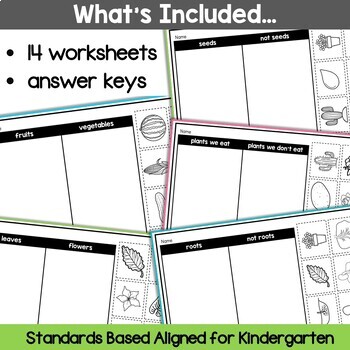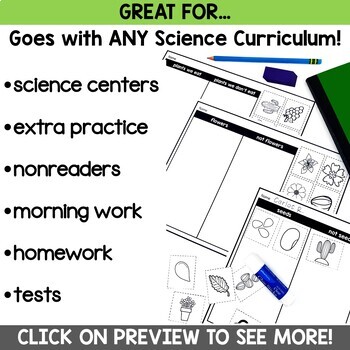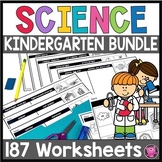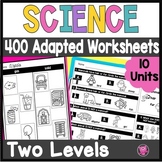Parts of a Plant Worksheet Sort - Plant Parts We Eat - Parts of a Flower
- PDF
What educators are saying
Also included in
- Practice and review Kindergarten Next Generation Science standards with these NO PREP NGSS science worksheets for kindergarten. This is a BUNDLE of YEARLONG science sort, cut, and paste worksheets that are quick and easy to use, great for nonreaders, and can be used with ANY science curriculum! YouPrice $31.50Original Price $41.99Save $10.49
- Struggling to find Adapted Science Worksheets for kindergarten, 1st grade, and your Special Education science units? This bundle of 400 science worksheets includes TWO LEVELS of differentiation gives students visuals to understand basic science concepts. These adapted science worksheets will go withPrice $64.99Original Price $86.00Save $21.01
Description
Learning about plant parts we eat, plant parts, trees, seeds, and life cycles of plants will be fun using these parts of plants sorting worksheets. These worksheets help students identify and sort parts of plants, plants parts we eat, the main parts of plants, roots, stems, leaves, seeds, flowers, fruits, and vegetables!
Students will sort, cut and glue plant parts and structures using these hands-on science activities that will go with ANY kindergarten science curriculum.
Quick, easy to use, and clear student directions make these plant sorting worksheets great for:
- nonreaders
- emerging writers
- extra practice
- independent work
- seatwork
- homework
- spiral review
- tests
You will be able to use these kindergarten science plant worksheets to help non readers understand science concepts, work independently, and even have on hand for substitute days too!
Click Here to SAVE with my YEAR-LONG Bundle!
This Parts of a Plant Science Packet Includes:
- Roots and Not Roots Worksheet
- Seeds and Not Seeds Worksheet
- Stems and No Stems Worksheet
- Leaves and Not Leaves Worksheet
- Vegetables and Not Vegetables Worksheet
- Flowers and Not Flowers Worksheet
- Fruits and Not Fruits Worksheet
- 2 Plants We Eat and Plants We Don’t Eat Worksheets
- Leaves and Flowers Worksheet
- 2 Fruits and Vegetables Worksheets
- Trees and Flowers Worksheet
- Plants and Trees Worksheet
- Teacher Answer Keys
Benefits of these Parts of a Plant and Plant Structures Science Worksheets:
- print and go
- easier to fit science into your day students can complete on their own
- great for substitutes
- daily practice and review
- answer keys make it easy grade
- takes about 5- 10 minutes to complete
Other useful resources can be found by clicking on the links below.
Plants and Animals Project Based Print and Go Unit
Plants and Animals | Structures and Interactions K-1st Grade Science Worksheets
Animal Habitats and Ecosystems Projects and Research Science Activities
Click Here to check out ALL of my K-1st Grade Science Resources!
CLICK here to FOLLOW me and SAVE 50% off my products the FIRST 24 HOURS POSTED!
Copyright ©Oink4PIGTALES
Permission to copy for single classroom use only.
Please purchase additional licenses if you intend to share this product.







